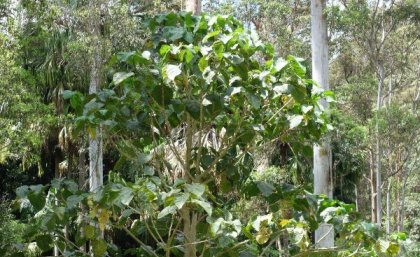The painful toxins wielded by a giant Australian stinging tree are surprisingly similar to the toxins found in spiders and cone snails, University of Queensland researchers have found.
The Gympie-Gympie stinging tree is one of the world’s most venomous plants and causes extreme long-lasting pain.
Associate Professor Irina Vetter, Dr Thomas Durek and their teams at UQ’s Institute for Molecular Bioscience found a new family of toxins, which they’ve named ‘gympietides’ after the Gympie-Gympie stinging tree.
The tree’s scientific name is Dendrocnide which literally means ‘stinging tree’ and is a member of the nettle family which can be found in Australia from the Northern Rivers region of New South Wales, through to Gympie, Queensland and all the way to the tip of the Cape York Peninsula.
“The Australian stinging tree species are particularly notorious for producing excruciatingly painful stings, which unlike those of their European and North American relatives, can cause symptoms that last for days or weeks,” Dr Vetter said.
“Like other stinging plants such as nettles, the giant stinging tree is covered in needle-like appendages called trichomes that are around five millimetres in length — the trichomes look like fine hairs, but actually act like hypodermic needles that inject toxins when they make contact with skin.”
Small molecules in the trichomes such as histamine, acetylcholine and formic acid have been previously tested, but injecting these did not cause the severe and long-lasting pain of the stinging tree, suggesting that there was an unidentified neurotoxin to be found.
“We were interested in finding out if there were any neurotoxins that could explain these symptoms, and why the Gympie-Gympie can cause such long-lasting pain,” Dr Vetter said.
The team found a completely new class of neurotoxin miniproteins that they termed ‘gympietides’, after the Indigenous name for the plant.
“Although they come from a plant, the gympietides are similar to spider and cone snail toxins in the way they fold into their 3D molecular structures and target the same pain receptors—this arguably makes the Gympie-Gympie tree a truly ‘venomous’ plant,” she said.
Dr Vetter said the long-lasting pain from the stinging tree may be explained by the gympietides permanently changing the sodium channels in the sensory neurons, not due to the fine hairs getting stuck in the skin.
“By understanding how this toxin works, we hope to provide better treatment to those who have been stung by the plant, to ease or eliminate the pain,” she said.
“We can also potentially use the gympietides as scaffolds for new therapeutics for pain relief.”
The research team hope that the gympietides will provide new information on how pain-sensing nerves function and contribute to developing new painkillers.
This research was published in Science Advances (DOI:10.1126/sciadv.abb8828) and funded by an Australian Research Council Discovery Grant.















